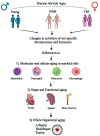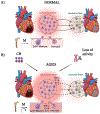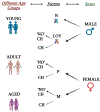Impact of age and sex on myelopoiesis and inflammation during myocardial infarction
- PMID: 38163742
- PMCID: PMC10922716
- DOI: 10.1016/j.yjmcc.2023.11.011
Impact of age and sex on myelopoiesis and inflammation during myocardial infarction
Abstract
Of all the different risk factors known to cause cardiovascular disease (CVD), age and sex are considered to play a crucial role. Aging follows a continuum from birth to death, and therefore it inevitably acts as a risk for CVD. Along with age, sex differences have also been shown to demonstrate variations in immune system responses to pathological insults. It has been widely perceived that females are protected against myocardial infarction (MI) and the protection is quite apparent in young vs. old women. Acute MI leads to changes in the population of myeloid and lymphoid cells at the injury site with myeloid bias being observed in the initial inflammation and the lymphoid in the late-resolution phases of the pathology. Multiple evidence demonstrates that aging enhances damage to various cellular processes through inflamm-aging, an inflammatory process identified to increase pro-inflammatory markers in circulation and tissues. Following MI, marked changes were observed in different sub-sets of major myeloid cell types viz., neutrophils, monocytes, and macrophages. There is a paucity of information regarding the tissue and site-specific functions of these sub-sets. In this review, we highlight the importance of age and sex as crucial risk factors by discussing their role during MI-induced myelopoiesis while emphasizing the current status of myeloid cell sub-sets. We further put forth the need for designing and executing age and sex interaction studies aimed to determine the appropriate age and sex to develop personalized therapeutic strategies post-MI.
Keywords: Age; Immunity; Myelopoiesis; Myocardial infarction; Sex.
Copyright © 2023 Elsevier Ltd. All rights reserved.
Conflict of interest statement
Declaration of Competing Interest The authors report no declarations of interest.
Figures



Similar articles
-
E-Selectin Inhibition Mitigates Splenic HSC Activation and Myelopoiesis in Hypercholesterolemic Mice With Myocardial Infarction.Arterioscler Thromb Vasc Biol. 2016 Sep;36(9):1802-8. doi: 10.1161/ATVBAHA.116.307519. Epub 2016 Jul 28. Arterioscler Thromb Vasc Biol. 2016. PMID: 27470513 Free PMC article.
-
Inhibition of FPR2 impaired leukocytes recruitment and elicited non-resolving inflammation in acute heart failure.Pharmacol Res. 2019 Aug;146:104295. doi: 10.1016/j.phrs.2019.104295. Epub 2019 Jun 16. Pharmacol Res. 2019. PMID: 31216426 Free PMC article.
-
Inhibition of pro-inflammatory myeloid cell responses by short-term S100A9 blockade improves cardiac function after myocardial infarction.Eur Heart J. 2019 Aug 21;40(32):2713-2723. doi: 10.1093/eurheartj/ehz461. Eur Heart J. 2019. PMID: 31292614
-
The role of myeloid-derived suppressor cells (MDSC) in the inflammaging process.Ageing Res Rev. 2018 Dec;48:1-10. doi: 10.1016/j.arr.2018.09.001. Epub 2018 Sep 21. Ageing Res Rev. 2018. PMID: 30248408 Review.
-
Assessment of medullary and extramedullary myelopoiesis in cardiovascular diseases.Pharmacol Res. 2021 Jul;169:105663. doi: 10.1016/j.phrs.2021.105663. Epub 2021 May 9. Pharmacol Res. 2021. PMID: 33979688 Review.
Cited by
-
Sex-dependent Pathophysiology and Therapeutic Considerations in Right Heart Disease.Can J Cardiol. 2025 Jun;41(6):1038-1053. doi: 10.1016/j.cjca.2025.02.034. Epub 2025 Mar 5. Can J Cardiol. 2025. PMID: 40054579 Review.
-
Glycolipid Metabolic Disorders, Metainflammation, Oxidative Stress, and Cardiovascular Diseases: Unraveling Pathways.Biology (Basel). 2024 Jul 12;13(7):519. doi: 10.3390/biology13070519. Biology (Basel). 2024. PMID: 39056712 Free PMC article. Review.
-
Progress and prospects of mRNA-based drugs in pre-clinical and clinical applications.Signal Transduct Target Ther. 2024 Nov 14;9(1):322. doi: 10.1038/s41392-024-02002-z. Signal Transduct Target Ther. 2024. PMID: 39543114 Free PMC article. Review.
References
-
- Ojha N, Dhamoon AS. Myocardial infarction. StatPearls [Internet]: StatPearls Publishing; 2021. - PubMed
Publication types
MeSH terms
Grants and funding
LinkOut - more resources
Full Text Sources
Medical

